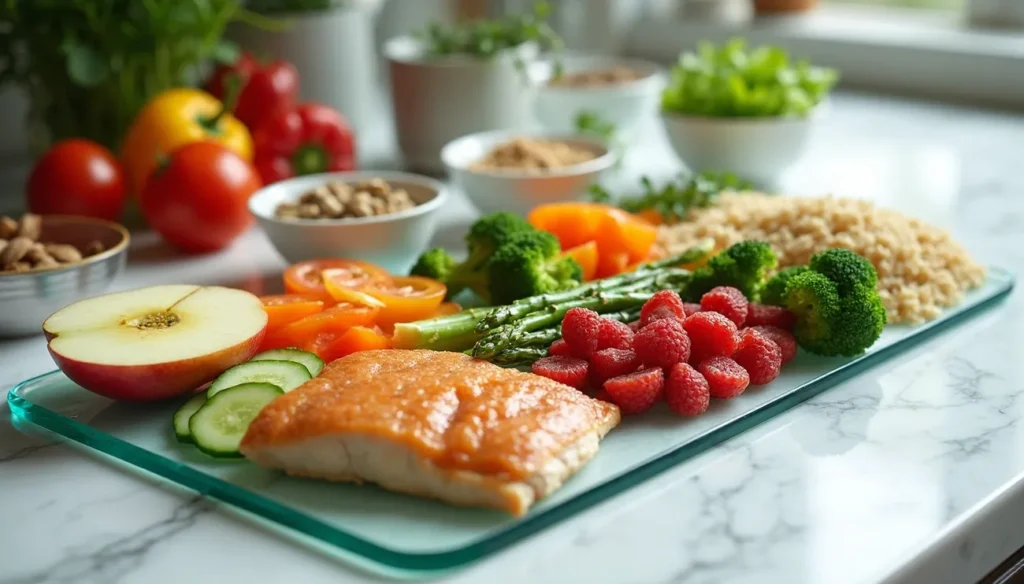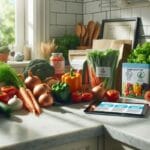How to Use Food Combining Charts: The Simple Guide to Better Digestion
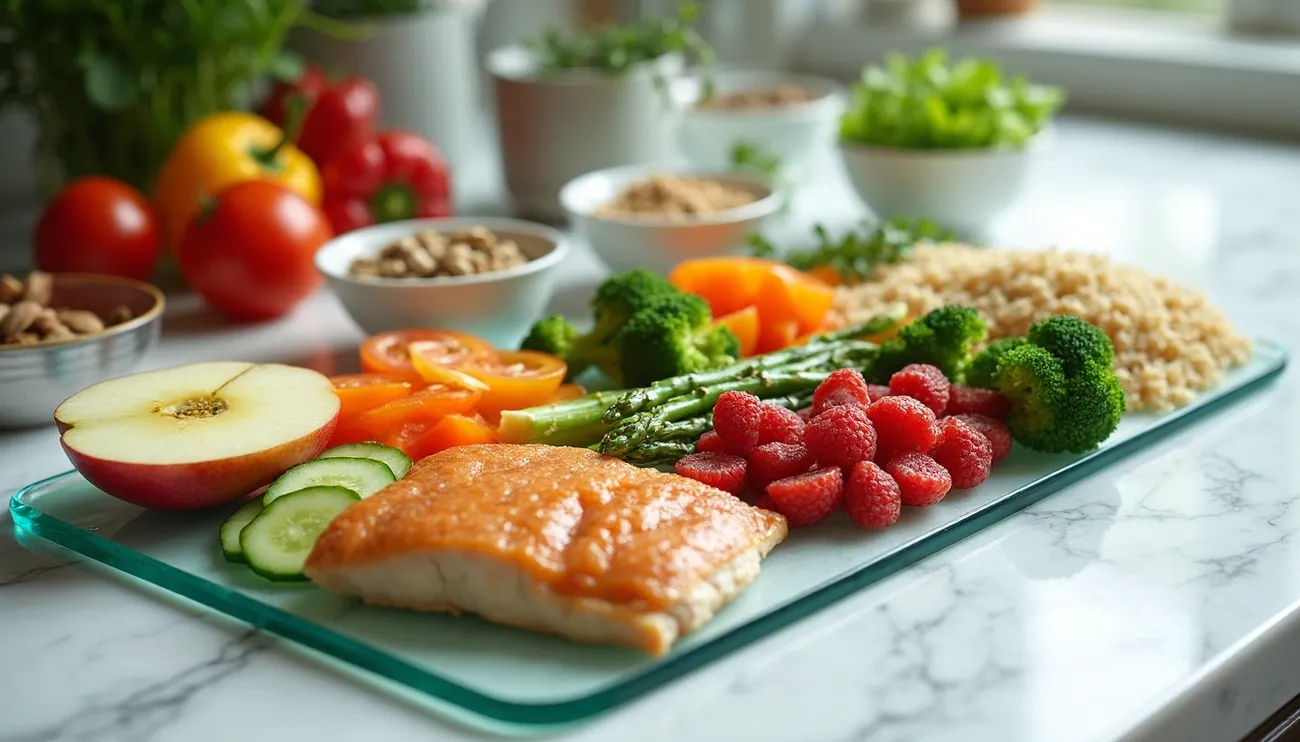
The human body uses more energy to digest food than any other function. This explains our tiredness after big meals. A food combining chart helps solve this issue by showing the best food pairings that aid digestion.
People notice much less gas and bloating just a week after they start combining foods properly. I’ve watched how the right food combinations boost energy levels and help with weight loss through better absorption of nutrients. The rules are simple – to name just one example, fresh fruit digests in about 30 minutes while other foods need much more time. This timing is significant to your digestive health.
Food left undigested in our system can ferment if we eat incompatible combinations. This creates toxins and makes our digestive tract acidic. But we can boost our digestion by learning basic rules like eating fruits alone or paired with leafy greens. On top of that, studies show we tend to eat too much when given many food choices. A healthy combinations chart naturally helps us eat less without calorie counting.
The Food Scan Genius app makes everything easier. Its AI-powered system and 35 customized filters help you shop smarter. The app is nowhere near as basic as others like Yuka, FoodisGood, or OpenFoodFacts.
Why Food Combining Matters for Digestion
Your digestive system starts working before you take your first bite. Your body arranges a complex system of enzymes, acids, and muscles that work together to extract nutrients from food. This process explains why proper food combining plays such a vital role in your digestive health.
How digestion works with different food types
Your digestive system uses specific enzymes and environmental conditions to process different foods. Proteins need acidic conditions and specific enzymes like pepsin to break down properly [1]. Carbohydrates start digesting in your mouth with salivary enzymes and continue in a more alkaline environment [2]. Your liver and pancreatic enzymes help break down fats [2].
Your body performs these functions when digestion works well:
- Breaks proteins into amino acids
- Converts fats into fatty acids and glycerol
- Transforms carbohydrates into simple sugars [2]
These nutrients pass through your intestinal walls to feed your entire body. Notwithstanding that, incompatible food combinations can disrupt this finely-tuned system.
Ayurvedic principles suggest that combining foods with drastically different energetics can overwhelm your digestive fire [3]. Proteins and starches need opposite digestive environments—acidic for proteins and alkaline for starches [4]. So, eating these together forces your body to compromise its digestive efficiency.
Common symptoms of poor food mixing
Poor food combinations demonstrate through clear digestive distress. Chronic diarrhea stands out as the most common symptom of malabsorption [5]. Problems with fat absorption can cause light-colored, greasy, and unusually foul-smelling stools—a condition called steatorrhea [5].
Watch for these signs:
- Bloating and abdominal discomfort
- Excessive gas and flatulence
- Unintentional weight loss despite adequate food intake
- Fatigue and low energy after meals [6]
These symptoms happen because improperly combined foods can ferment in your digestive tract. This process disrupts your good gut bacteria and creates an environment where harmful microbes thrive [1]. Toxins and acidic conditions further reduce your digestive capabilities.
How food combining can help
Good food combining creates harmony in your digestive system by respecting how different foods digest. In fact, research shows that humans eat more when faced with too many food options during a meal [1]. Simple meals naturally reduce calorie intake without counting or restricting portions.
Food combining principles can improve digestion within days. People report less bloating, smoother digestion, and more regular bowel movements first [1]. A food combining chart can reduce digestive gas and abdominal discomfort by a lot [7].
Food Scan Genius app makes this process easier. Unlike Yuka, FoodisGood, or OpenFoodFacts, it uses an AI-first approach with 35 tailored filters that help you make better food choices while shopping. The app spots compatible food combinations and alerts you about problematic pairings based on your dietary needs.
Note that food combining isn’t about strict rules but offers a tool to improve digestive health [3]. Following these principles 80% of the time can improve how you feel after meals by a lot.
The 4 Core Food Combining Principles
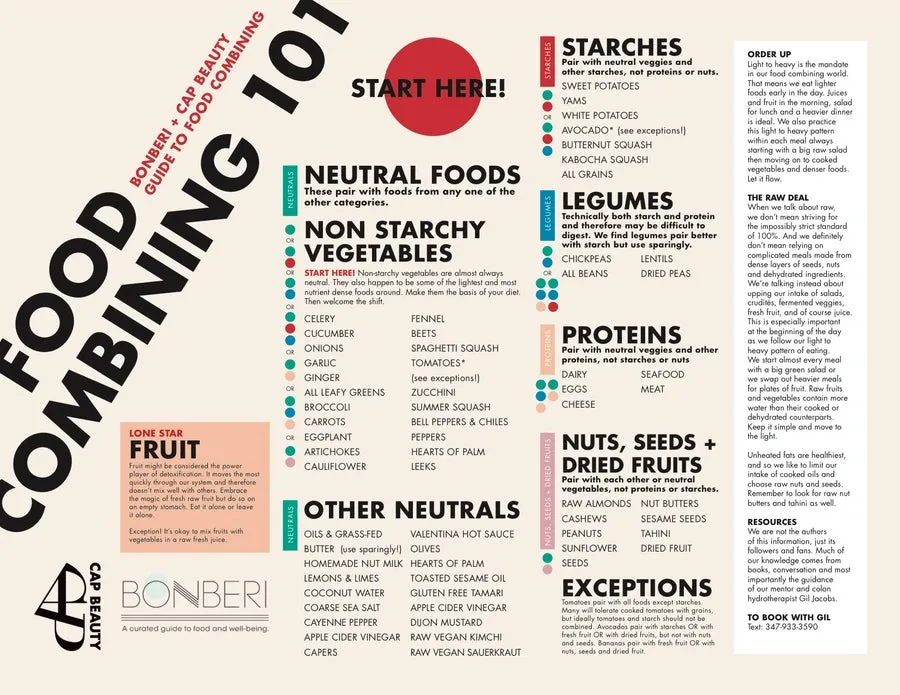
Image Source: CAP Beauty
Food combining works on practical principles that make eating simpler. These principles aren’t just theories—they’re based on how our digestive system processes different foods naturally. I became skilled at these four core rules, and my digestive problems improved faster within days.
1. Avoid mixing proteins and starches
The science is pretty straightforward: proteins need an acidic environment with enzymes like pepsin and hydrochloric acid. Starches need alkaline conditions with enzymes like amylase and ptyalin. Your body creates a “traffic jam” in your intestines when it tries to digest both at once.
Common problematic combinations include:
- Meat with potatoes
- Spaghetti and meatballs
- Fish and chips
- Hamburgers
- Chicken with rice
You should wait at least 2 hours after eating grains before trying other foods. After animal protein, wait 3 hours before eating starches. Your best meal might be fish with non-starchy vegetables or a quinoa stir-fry with vegetables (but skip the animal protein).
2. Eat fruits alone or with leafy greens
Fruits digest faster—usually within 20-30 minutes—because they contain lots of water. Fruits get stuck in your stomach and ferment when mixed with slower-digesting foods. This creates gas and bloating. The fermentation can feed harmful bacteria and mess up your gut microbiome.
Eating fruit on an empty stomach works best, especially first thing in the morning. After a meal, wait 3-4 hours before having fruit. Melons need special care—eat them completely alone, not even with other fruits.
There’s one exception: fruits mix well with leafy greens, so green smoothies work great. Berries and less sweet fruits usually cause fewer problems when mixed with other foods.
3. Combine protein fats with non-starchy vegetables
Protein fats like nuts, seeds, olives, and cheeses digest well with non-starchy vegetables. Think broccoli, cauliflower, asparagus, spinach, kale, and other leafy greens. This combo works because these vegetables digest well in both protein and starch-friendly environments.
Mixing protein fats with fruit can help control blood sugar by slowing sugar absorption. Protein fats with non-starchy vegetables make filling meals that your digestive system handles easily.
Clinical research shows vegetables need fat-containing dressings to absorb their carotenoids—compounds that protect against chronic diseases. Adding healthy fats to vegetable dishes isn’t just okay—it helps your body.
4. Use magic foods that pair with anything
Some versatile foods—called “magic foods” or “star foods”—mix well with everything. These make food combining much easier:
- Leafy greens (spinach, kale, chard, collards, bok choy)
- Lettuces (butter, romaine, arugula)
- Fresh herbs (basil, mint, parsley, cilantro)
- Lemons and limes
- Avocados
- Coconut
- Cucumbers
- Bell peppers
- Tomatoes
- Zucchini and summer squashes
- Olives
These foods are great “bridges” between different food categories. They’re packed with nutrients and boost overall health.
The Food Scan Genius app makes these principles easy to follow. Unlike Yuka, FoodisGood, or OpenFoodFacts, this free app takes an AI-first approach. It has 35 customized filters to help you find compatible food combinations while shopping. The app analyzes products right away and suggests better options based on food combining principles.
Using just one or two of these principles can improve your digestion by a lot. Start with the rule that seems easiest, then add others as you get comfortable with this way of eating.
Timing Rules for Better Digestion
The right timing between meals holds the key to discovering the full benefits of food combining. My experience shows that even perfectly combined foods can upset your digestion if you eat them too close together. Let’s look at the significant timing rules that help your digestive system work at its best.
How long to wait between meals
Your digestive system needs enough time between meals to finish its “cleaning” process. Your gut works as a “migrating motor complex” during these breaks and contracts to move undigested food through your system [8]. Most people should wait 3-4 hours between properly-combined meals [1].
Different food types need specific waiting periods:
- After eating grains or complex carbs: Wait at least 2 hours before eating other foods [9]
- After consuming animal protein: Wait at least 3 hours before eating starch or fruit [9]
- Between switching food categories: Wait 3-4 hours for complete digestion [1]
- Between protein and starch meals: Wait at least 3 hours, but 5 hours works better [10]
Eating too often disrupts this vital digestive reset process. Your system keeps working without proper breaks.
Best time to eat fruit
Fruit digests quickly—usually within 30 minutes [1]. So, you should eat fruit:
- First thing in the morning on an empty stomach
- As an afternoon snack (3-4 hours after your last meal)
- About 30 minutes before your main meal [9]
Some people say eating fruit after 2 p.m. raises blood sugar that your body can’t balance before bed. However, no scientific evidence backs this theory [11]. The empty stomach matters more than the time of day for fruit consumption.
Meal spacing for optimal gut health
Meal timing affects your body’s circadian rhythm beyond simple digestion. Regular eating times help create consistent digestive patterns [12]. Studies show that time-restricted eating—eating all daily calories within an 8-12 hour window—might boost metabolism and heart health [13].
Food Scan Genius app makes these timing rules easy to follow. The app’s AI-first approach with 35 individual-specific filters sets it apart from Yuka, FoodisGood, or OpenFoodFacts. This free tool tracks food combinations and optimal eating windows. You’ll get gentle reminders about waiting periods between meals based on your previous food choices—like having a food combining chart in your pocket.
Note that everyone’s digestion is different. Some people need just 30 minutes between certain foods, while others might need two hours [14]. These guidelines give you a starting point. Your body’s response will help you adjust them.
How to Read and Use a Food Combining Chart
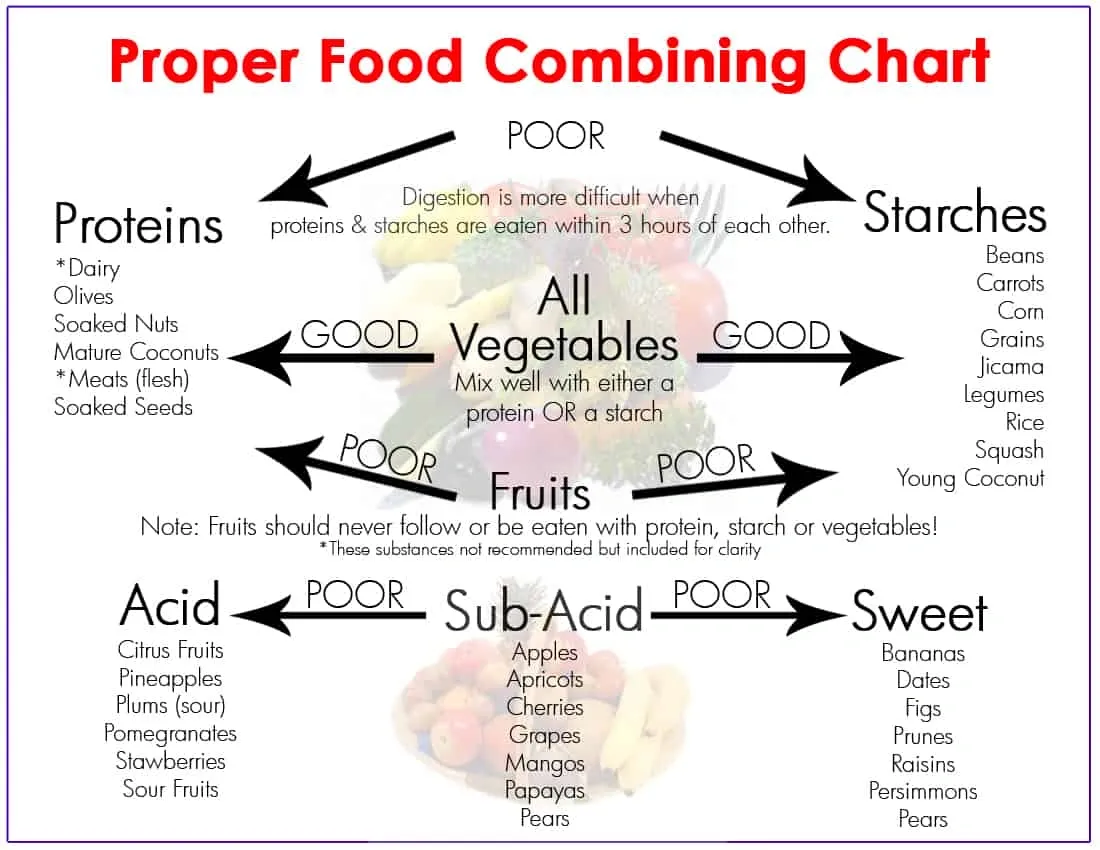
Image Source: Reddit
A food combining chart acts as your roadmap to digestive harmony. Learning to interpret these visual guides will reshape the scene of your meal planning and reduce digestive problems.
Understanding food categories
Food combining charts organize foods into four main categories:
- Fruits: All raw and cooked fruits including berries, apples, citrus fruits, melons
- Starches: Grains plus starchy vegetables like potatoes and winter squash
- Animal proteins: Meat, poultry, fish, eggs, and dairy products
- Nuts/seeds/dried fruits: All nuts, seeds, coconut, and dried fruits [15]
You’ll find “neutral foods” that mix well with anything—these include non-starchy vegetables, healthy fats like olive oil, lemons, limes, and most non-dairy milks [15]. These categories are the foundations of proper food combining.
Using the chart to plan meals
Select ONE category for each meal, then add items from the “neutral” column to complete your plate [1]. The simple rule makes sense—foods within the same category mix well together.
Your body needs about one hour between consuming foods from different categories [4]. It’s worth mentioning that your individual digestion might need more or less time—listen to what works for your body [16].
The Food Scan Genius app makes this process simple. The app’s AI-first approach with 35 tailored filters spots compatible food combinations while shopping, setting it apart from Yuka, FoodisGood, or OpenFoodFacts.
Examples of healthy food combinations chart
Well-combined meals might include:
- A vegetarian sandwich on whole-grain bread with avocado, vegetables, and a side salad [15]
- A protein meal featuring fish with non-starchy vegetables cooked in healthy fats [15]
- A fruit-based meal (eaten alone, ideally in the morning) [1]
Combinations to avoid include:
- Sandwiches with meat/cheese on bread
- Smoothies containing dairy and fruit
- Salads with both grains and animal proteins [15]
Food combining charts are a great way to get guidance, not strict rules. They help you spot incompatible food groups while suggesting better combinations [4].
Make It Easy with the Food Scan Genius App
The right technology in your pocket makes food combining rules easy to follow. The Food Scan Genius app changes complex food combining principles into simple, applicable information you can use while grocery shopping or planning meals.
How the app helps you combine food properly
Food Scan Genius uses advanced AI technology to scan barcodes and analyze food products instantly [17]. The app assesses ingredients against food combining principles and highlights any incompatibilities when you scan items. The app’s recipe suggestions based on your scanned items turn your shopping from product-focused to meal-oriented [18]. This feature helps beginners follow proper food combining without memorizing complex charts.
The sort of thing I love about Food Scan Genius is its ability to analyze products through AI search capabilities, even when they’re not in its database [2]. This solves the common “product not found” issue that plagues other food apps. The app suggests better alternatives that line up with food combining rules when you scan incompatible food combinations.
Personalized filters for dietary needs
Food Scan Genius comes with an impressive 35 personalized filters that adapt to your specific dietary profile [18]. Set your priorities once, and the app remembers everything:
- Food allergies and sensitivities
- Dietary patterns (including those based on food combining principles)
- Ingredients you prefer to avoid
- Nutritional goals
The app customizes every recommendation to your specific needs—not generic advice [18]. The app helps identify potentially problematic ingredients that hide under unfamiliar names [18], so nothing disrupts your food combining efforts.
Why it’s better than Yuka and other apps
We focused on making Food Scan Genius the market’s only true AI-first nutrition solution [2]. Apps like Yuka, FoodisGood, and OpenFoodFacts use static databases that often miss regional products or newer items [19].
The app gives context about ingredients instead of just flagging them. Users learn about ingredients rather than getting unnecessary warnings [19]. Food Scan Genius adapts easily to regional differences in product formulations [19], making it valuable whatever store you shop at.
Download the Food Scan Genius app today and bring back the joys of shopping. Its intelligent assistance will help you make food combining principles feel natural rather than challenging.
Conclusion
Food combining is a practical way to revolutionize your digestive health without complex diet restrictions. This piece explores how understanding core principles can make a real difference. Separating proteins from starches, eating fruits alone, and following proper meal timing can reduce common digestive problems like bloating and gas by a lot. On top of that, these simple changes often boost your energy levels as your body uses less energy for digestion.
Your transition to proper food combining doesn’t need an all-or-nothing approach. Even small changes like eating fruit on an empty stomach or spacing out your meals properly can lead to noticeable improvements. Most people see positive changes within days, not weeks, when they follow these guidelines.
Food combining’s beauty lies in its flexibility. While it follows scientific principles about food digestion, you can adapt these rules to your body’s needs. Unlike strict diets, this approach creates harmony in your digestive system through smart food pairings rather than cutting out foods.
Modern technology makes this process easier than ever. The Food Scan Genius app brings back the joy of shopping. This free tool outshines alternatives like Yuka, FoodisGood, or OpenFoodFacts with its AI-first approach. Its 35 customized filters help you make better food choices while shopping.
Note that better digestion affects more than just your after-meal comfort. Your body’s efficient nutrient processing leads to improved energy levels, clearer thinking, and maybe even weight management benefits naturally. Food combining is a gentle yet powerful tool that optimizes digestive wellness without dramatic dietary changes.
FAQs
Q1. What is the basic principle of food combining for better digestion?
The basic principle of food combining is to eat certain foods separately to optimize digestion. This includes avoiding mixing proteins and starches, eating fruits alone or with leafy greens, and combining protein fats with non-starchy vegetables.
Q2. How long should I wait between meals when practicing food combining?
Generally, you should wait 3-4 hours between meals when switching food categories. For example, wait at least 2 hours after eating grains before introducing other foods, and at least 3 hours after consuming animal protein before eating starches.
Q3. Are there any foods that can be combined with anything?
Yes, there are “magic foods” that pair well with almost anything. These include leafy greens, fresh herbs, lemons, limes, avocados, cucumbers, bell peppers, and tomatoes. These versatile foods can be added to most meals without causing digestive issues.
Q4. How can food combining help improve my digestion?
Food combining can help improve digestion by reducing gas, bloating, and abdominal discomfort. It also supports better nutrient absorption, increases energy levels, and may aid in weight management by naturally reducing overall food intake without calorie counting.
Q5. Is there an easy way to implement food combining principles while shopping?
Yes, the Food Scan Genius app is a helpful tool for implementing food combining principles. It uses AI technology to analyze food products, suggest compatible combinations, and offer personalized recommendations based on your dietary needs and preferences.
References
[1] – https://detoxinista.com/food-combining/
[2] – https://scangeni.us/food-scanner-app-guide-which-one-actually-helps-make-better-choices/
[3] – https://www.banyanbotanicals.com/pages/ayurvedic-food-combining?srsltid=AfmBOooOVdc2DPIqPnvR3vQrZn-bL7p0yi8goQSO5M-bhPauFGpMJGph
[4] – https://www.banyanbotanicals.com/pages/ayurvedic-food-combining?srsltid=AfmBOooxIIVd4ILb3-ituxCrbMg_lXG__lKsafqQEaQJpLZ82ISCleL-
[5] – https://www.merckmanuals.com/home/digestive-disorders/malabsorption/overview-of-malabsorption
[6] – https://my.clevelandclinic.org/health/diseases/22722-malabsorption
[7] – https://www.optimumhealth.org/blog/the-benefits-of-food-combining
[8] – https://www.mindbodygreen.com/articles/how-long-you-should-wait-between-meals-for-optimal-digestion-optimal-meal-timing-for-digestion?srsltid=AfmBOorhT8BHPmJ8hA5jjJxMP_pSEyEMTk-UycFlrP_7kidp9cF_3WH8
[9] – https://navacenter.com/food-combining-explained/
[10] – https://www.theblendergirl.com/hint-tip/food-combining/
[11] – https://www.healthline.com/nutrition/best-time-eat-fruit
[12] – https://wellbeing.jhu.edu/blog/2022/12/09/timing-is-everything-why-eating-on-a-regular-schedule-supports-overall-well-being/
[13] – https://pmc.ncbi.nlm.nih.gov/articles/PMC7213043/
[14] – https://www.banyanbotanicals.com/pages/ayurvedic-food-combining?srsltid=AfmBOoqYu8L3rtOS2STTnriJAJ8ItT-5_WZrH28btNdb37H5uPRYLCEQ
[15] – https://ancientnutrition.com/blogs/all/food-combining?srsltid=AfmBOoqAuBVECgbI9Kb5i_3HqONU3hOPht-FStXt450U8uQkrtKc3MhQ
[16] – https://www.banyanbotanicals.com/pages/ayurvedic-food-combining?srsltid=AfmBOorESi7XP0keFt-wos0Vf1fCJU-qr2g4UMDmhCrNODnMnCTmZKSp
[17] – https://scangeni.us/faq/
[18] – https://scangeni.us/food-scan-genius-generative-artificial-intelligence/
[19] – https://scangeni.us/yuka-app-review-is-it-actually-accurate-i-tested-100-products/

